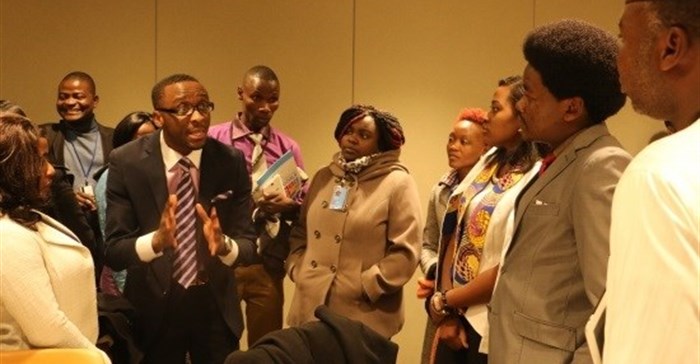
Subscribe & Follow
Advertise your job vacancies
Youth dividend or ticking time bomb?
As the African Union marks 2017 as the ‘Year of Harnessing the Demographic Dividend Through Investments in Youth', this special edition looks at the many challenges and opportunities facing Africa's youth today in the fields of skills training, technology, entrepreneurship, agribusiness, advocacy and political activism, among others.

Participants at the United Nations Youth Forum held in New York in January this year. Credit: Africa Renewal/Ihuoma Atanga
“People talk about a demographic dividend for Africa. What we have now in Africa is not the ‘dividend,’ it is just a youth population bulge,” Ahmad Alhendawi, the former United Nations youth envoy, told Africa Renewal.
“A dividend is the result of your investments. If you invest well, you get results. But that doesn’t happen by itself.”
UN data leads us to look at Africa as the continent where countries have more people under 18 than on any other continent in the world. Further, the youth population in Africa is projected to double by 2050, which will place more and more stress on already strained resources for the region.
Depending on how governments respond to this reality, an exponentially expanding population of youth can turn into a ticking time bomb or a demographic dividend, defined by UN experts as the economic growth that ensues when there are more working-age people (15 to 64) than the non-working people (14 and younger, and 65 and older).
The alternative to a youth dividend is a youth bulge, which is characterised by high youth unemployment and widespread protests - a recipe for political instability. Frustrated by the lack of opportunities, many of Africa’s young people are risking their lives on perilous journeys in search of a better life in Europe. Pools of idle youth are a magnet for recruiters from rebel or extremist groups.
The youth population in Africa is projected to double by 2050, which will place more and more stress on already strained resources for the region.
Governments should invest in projects that create jobs or enable youth to start their own businesses. They should also make agriculture more attractive to youth, promote technology, improve young people’s skills and make school curricula relevant to the needs of job markets.
Furthermore, they should pass and implement laws that end cultural practices which promote child marriages or keep girls away from school. Governments need to support gender equality, empower women and girls, crack down on teenage pregnancies and tackle communicable diseases.
Leaders frequently say they are keen to listen to young people, engage them when they design policies and make decisions on matters that affect them. The reality is that these decisions are often made with little or no input from youth.
What the leaders end up with are policies that purport to improve the lives of young people when in fact they lack the perspective of what youth really want.
Young people want their leaders to listen to their worries, take them seriously and offer practical answers. It was therefore encouraging when Frederick Shava, the current president of UN Economic and the UN Social Council (ECOSOC), commended young people at the just-ended 2017 Youth Forum for “specific and frank assessments” of their concerns. He promised to strengthen their voices and participation “in building the future we want” in Africa.
Source: Africa Renewal.


